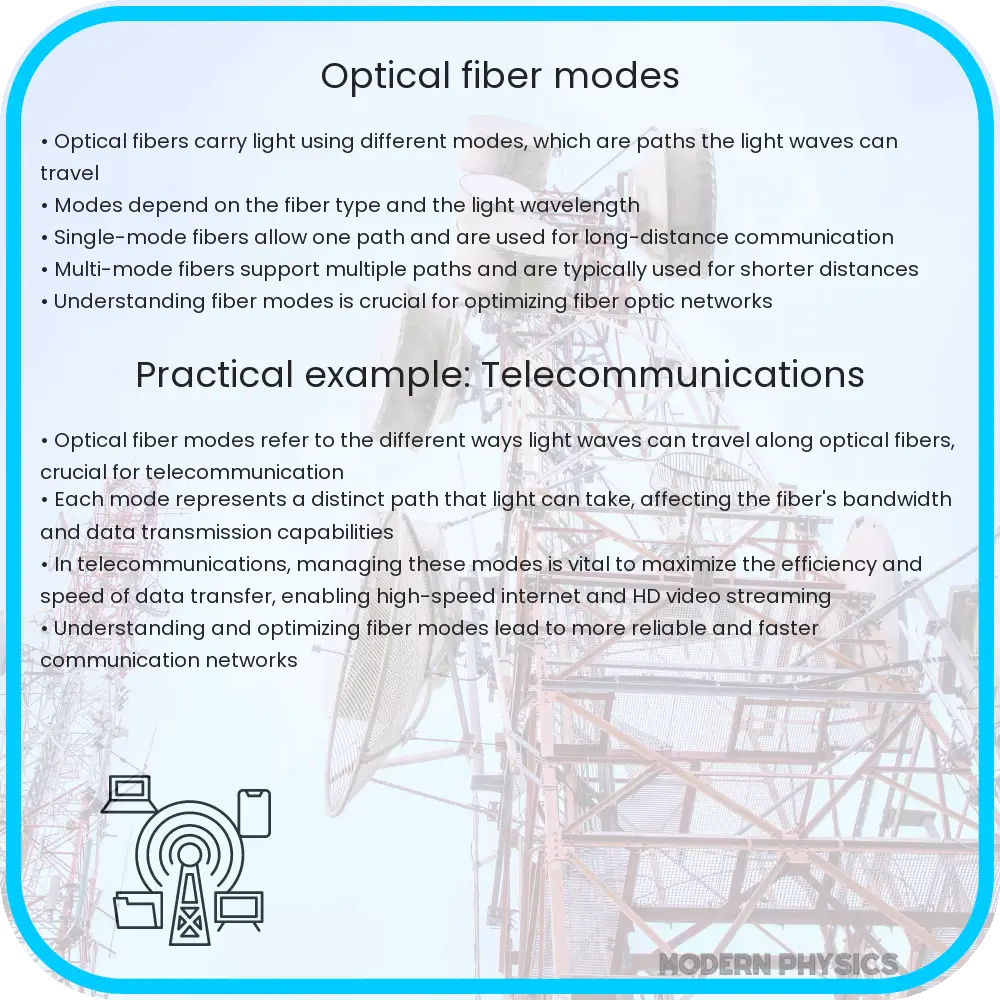Explore the differences between single-mode and multi-mode optical fibers, their impact on network speed, bandwidth, and clarity for efficient communication.

Understanding Optical Fiber Modes
Optical fiber technology is a cornerstone of modern communication, enabling the transmission of data over long distances at high speeds. The efficiency and performance of optical fibers depend significantly on their modes, which are the paths that light waves can take as they travel through the fiber. This article delves into the concepts of optical fiber modes, their impact on speed, bandwidth, and signal clarity, and why they are pivotal for telecommunications and data networks.
Single-Mode and Multi-Mode Optical Fibers
Optical fibers can be categorized into two primary types based on the mode of light they support: single-mode (SMF) and multi-mode (MMF). Single-mode fibers allow only one path for light to travel, essentially eliminating modal dispersion, a phenomenon that can blur the signal over long distances. This single path is made possible due to the narrow diameter of the fiber’s core, typically around 9 micrometers (μm). On the other hand, multi-mode fibers have a larger core diameter, usually between 50 and 62.5 μm, which supports multiple paths for light. This characteristic makes MMF suitable for shorter distances, as modal dispersion can significantly affect signal quality over longer lengths.
Speed and Bandwidth Considerations
The choice between single-mode and multi-mode fibers directly impacts the network’s speed and bandwidth. Single-mode fibers offer higher bandwidth and longer transmission distances than multi-mode fibers. This is because the absence of modal dispersion in SMF allows for the use of higher bandwidth signals, which can be transmitted over longer distances without significant loss of signal quality. Multi-mode fibers, while offering lower bandwidth over shorter distances, are often preferred for cost-effective solutions in local area networks (LANs) and data centers where high-speed, short-distance communication is required.
Signal Clarity and Transmission Quality
Signal clarity in optical fibers is influenced by factors such as dispersion and attenuation. Dispersion, which includes modal and chromatic dispersion, can cause a broadening of the signal, leading to overlap and interference between the transmitted pulses. Single-mode fibers, with their single light path, significantly reduce the risk of modal dispersion, ensuring clearer signal transmission over long distances. Chromatic dispersion, affecting both SMF and MMF, is managed through careful design of the fiber’s refractive index profile and the use of dispersion-compensating techniques.
Enhancing Performance with Advanced Technologies
Advancements in optical fiber technology continue to push the boundaries of what is possible in terms of speed, bandwidth, and signal clarity. Techniques such as Dense Wavelength Division Multiplexing (DWDM) and the deployment of erbium-doped fiber amplifiers (EDFAs) have significantly improved the performance of optical fibers. DWDM allows for multiple signals to be transmitted simultaneously on different wavelengths, effectively multiplying the fiber’s capacity without increasing its physical size. EDFAs, on the other hand, boost the signal strength without converting the light signal into electrical signals, enabling longer transmission distances without degradation.
Choosing the Right Fiber for Your Application
The choice between single-mode and multi-mode optical fibers depends on the specific requirements of the application, including the desired transmission distance, bandwidth, and budget constraints. For long-distance telecommunications and backbone network applications where maximum bandwidth and minimal signal loss are critical, single-mode fibers are the preferred choice. Conversely, for shorter distances and applications where cost is a significant factor, such as within data centers or enterprise networks, multi-mode fibers offer a viable and efficient solution.
Conclusion
Understanding the modes of optical fibers is crucial for optimizing the performance of communication networks. Single-mode fibers, with their ability to transmit signals over long distances with high bandwidth and minimal signal loss, are ideal for telecommunications and critical network backbones. Multi-mode fibers, offering cost-effectiveness for short-distance applications, play a vital role in LANs and data centers. With ongoing advancements in optical fiber technology, such as DWDM and EDFAs, the capabilities of these fibers continue to expand, promising even faster, more reliable, and higher capacity communications networks. The choice between single-mode and multi-mode fibers ultimately depends on balancing the requirements of speed, bandwidth, distance, signal clarity, and cost to meet the specific needs of each application.
